|

IN THE DAYS OF JAKEY
HAMILTON
By John McGrehan
Early in the 1870's a man named John Hamilton later known
as Jakey Hamilton came to Dromore. He came to work his
patents in hemstitching and embroidering for the sole use of
Henry Matier & Co. of Belfast. He had several patents in
this particular field of activity. He made a beginning in
rooms in Market Square but after a time he purchased some
ground in Meeting Street on which he built a factory, which
extended from the street to the edge of the River Lagan, in
which he continued to work his patents and to improve
hemstitching machinery.
The factory was considered to be a most modern one for
it's time, being built with scotch brick and bordered with
coloured brick in Georgian style. Some time about 1900 this
factory was destroyed by fire and it would appear that only
the gable at the side of the river was left standing. In
later years, when alterations were made to windows, small
portions of burned beams were discovered in this section of
the building. When the factory was being re-built it is
thought that the brick used came from the brickfield which
was only a short distance from the factory site.
During the late 1880's it is recorded that a mill in
Dromore was owned by E. McCartney. This mill was situated
off Church Street at the bottom of what is now known as Mill
Lane and was powered by a water wheel and up to some years
ago this old wheel could still be seen from Downshire
Bridge. The water to run this wheel came by way of a race
which started from the Weir Stones down by the side of a
field at the Mount, passing by the side of Graham's Yard,
along the bottom of Mount Street, right across the side of
the Square down to the mill. After powering the wheel the
water then re-entered the River Lagan. Furthermore, the
portion of the original race that was in Mount Street was
open with a well on each side, the Urban Council had it
covered over and it was used for car parking.
At the beginning of the century the mill buildings, race
and adjoining ground were taken over by Mr. Hamilton who
paid a rent of �72.00 per year. There must have been some
vacant ground convenient to the mill available for building
as some shops were erected in Church Street/Bridge Street
and it is believed Mr. Hamilton was responsible for building
these as he was a great person for erecting buildings with
flat roofs! It is thought that this was to save rates.
Before we leave the buildings in Church Street an amusing
tale is told of the building at the corner of Church
Street/Bridge Street. It is said that "the powers that be"
asked Mr. Hamilton to have the building erected with a
sloped corner but unfortunately they could not agree on the
amount of money needed to do this. Mr. Hamilton had the
first storey made with a square corner and from the second
story up the building was made with a sloped corner the way
that the Authorities wanted the building done in the first
place, so there were awkward people even in those days!
Mr. Hamilton must have been a great engineer in his time
as he planned to have the factory erected in the early
1900's to be powered by water. About 200 yards down from the
start of the original race he had this race tapped and
brought the water from the race over the river by means of a
wooden aqueduct he caused to have erected. Mr. Hamilton
owned land on which he had built Otter Lodge and this
aqueduct was joined to a race he had made at the side of
Otter Lodge grounds to the factory. The water from the race
came downstairs into a portion of building built at the side
of the factory in which were placed 2 turbines through which
the water went into the river. One of these turbines
supplied power for the machinery and the other turbine used
to power a dynamo to generate electricity. The turbines were
supplied by John McDonald of Glasgow and the dynamo by
Geoghegan of Banbridge. The flow and supply of water in the
race was regulated by means of sluices. Some yards down from
the River Lagan at the side of Weir Stones where the race
started, there was a large sluice. During the summer and at
times when there was a scarcity of water this sluice was
closed down at evenings to let the water gather and when it
was opened in the morning there was mostly sufficient water
to keep the turbine providing power for the factory all day.
In the original race just down below where the aqueduct
joined the race there was a sluice. The purpose of this
sluice was two-fold; one to stop the water continuing down
the original race and directing it into the aqueduct and
second if there was too much water going into the aqueduct
to open this sluice so that the surplus water could escape
down the original race. Then there was a sluice at the
beginning of the aqueduct and when this was closed it meant
that no water could get into it so that necessary renewals
and repairs could be carried out. There was also a sluice
some 30 or 40 yards from the factory which was opened every
night to let the water from the race go direct into the
river and thus preventing the race overflowing and flooding
into the factory. The new factory that was built early in
1900's was a three storey building and was one of the first
in the country in which machines were power driven and
lighted up by electricity.
The power provided by the turbine was on the whole most
successful and provided power for some 60 to 90 machines.
The only time that the machines were not going as quickly as
required was when there was a flood in the river and this
prevented the water from the race getting through the
turbine and back into the race as quickly as necessary, but
this did not happen very often! When this did happen the
girls working the machines soon let it be known and shouted
"more steam!" The turbine used to generate electricity was
most successful, the only problem was in turning on this
turbine it was important not to turn it on to quickly in
case some of the bulbs would be blown.
The ground floor of the building was used for laundering
the goods and was most complete and up to date as there was
a power driven washing machine and a large smoothing
machine. There was also a section of the room used for hand
smoothing and for making up, boxing and parcelling the goods
ready for dispatch.
In the middle storey of the factory the machines were
placed and worked by the girls.
The top storey of the factory was used for cutting the
goods ready for stitching and printing ready for embroidery.
A section of this room was used for packing the goods into
cases and cartons ready for despatch all over Great Britain
and sometimes some went as far as Canada and Australia. On
this top room was also a section for the offices.
The products of this factory were a large selection of
household goods such as bedspreads, sheets, tea cloths, tray
cloths, table cloths, valances, pillow cases and bolster
cases.
John Hamilton lived in Otter Lodge which he had built,
probably with brick from the brickfield across the road. In
the factory there was a spring and he had the water from
this spring piped up to his residence and by means of a pump
powered also from the turbine a supply of water was pumped
up to the house when required.
At the beginning this firm was known and run under the
name of John Hamilton Hemstitcher and Manufacturer of Fancy
Goods with the address of The Factory, Dromore.
|
Trade Notice.
Messrs. John Hamilton & Co., The Square, Dromore.
Every housewife loves fine linen,
and on the right selection depends much of her
future comfort. If she deals with Messrs. John
Hamilton & Co., The Square, Dromore, she will be
assured of the utmost value at extremely low prices.
Everything in Linen for the household can be
procured here, sheets, pillow cases, table cloths,
etc. all of the finest quality. |
In 1908 a firm was floated under the name of Hamilton
McBride & Co. Ltd. to take over the business of John
Hamilton with John Hamilton as Managing Director, his
daughter Nellie as secretary, other shareholders being
members of his family and James Crossin McBride who resided
at York House, Dromore. Over the years the shares changed
ownership but the firm continued to operate in Dromore until 1968 when it moved over to Manchester and is still
producing and selling household textiles up to the present
time.
It is said that John Hamilton was a most eccentric man
and was related to the Nelson family who had a General
Drapery, Boot Warehouse and Pawnbroking establishment in
Rampart Street. The story is told that Joe Nelson wanted to
borrow hedge clippers from John Hamilton and sent a boy up
to ask for them. The boy went up and said "Jakey, Mr. Nelson
wants the loan of your hedge clippers", to which John
Hamilton replied, "Tell Joe Nelson that Mr. Hamilton is
using the hedge clippers!"
Many stories were told about John Hamilton but after a
very busy and eventful life he died on 27th January, 1919,
and is buried in First Dromore Presbyterian Graveyard.

|
Oshawa,
Ontario,
Canada, LIG 1133
Mr. Jim Hutchinson,
28 Milebush Road,
Ballymacormick, Dromore,
April 28, 1994
Co. Down, N. Ireland.
Dear Mr Hutchinson,
I have just read Volume 3 Journal and thoroughly
enjoyed it. These books about Dromore are so
interesting, I hope there will be many more.
The Editorial Committee may find the enclosed
story interesting, and if so, have my permission
to print it.
Sincerely,
Mrs Norma (McClughan) Kerr |
* * *
THE
GRAVE SNATCHER
By Norma Kerr
The late Richard John Mercer and his spinster sister
Mary, used to own a farm near the top of the Diamond Hill in
Skeogh - I think a Mr. Gribben lives there now. Richard John
died in the late 1940's when he was in his eighties. During
the last few years of his life, he was very frail. My
father, the late Thomas John McClughan used to go to his
house twice a week to shave the old gentleman. As a
youngster, I often went with my father to watch Mr. Mercer
get his shave and I heard many stories. Here is one of those
stories which is still very vivid in my mind today.
This must have happened in the late 1880's when Richard
John was a young man. Someone in the neighbourhood had died
and was buried in First Dromore Graveyard. I can't remember
who the person was or if they were male or female. The day
following the burial, it was discovered that the grave had
been re-opened, the coffin empty, and the corpse gone. The
next day, before dawn, Richard John and a relative of the
deceased set off in a horse and cart for Belfast. Upon
reaching Belfast, they made their way to the docks where
they saw a man carrying a sack over his shoulder. Richard
John recognised this man, his name was McNutt. When Mr.
McNutt saw the two gentlemen, he immediately dropped the
sack and ran. Sure enough, inside was the stolen corpse.
Richard John and his friend did not return the stolen body
to First Dromore graveyard, but had it buried in a graveyard
outside Belfast. This Mr. McNutt lived half way along a lane
at the bottom of Diamond Hill - the late Mariah McClune
lived in the same house later. I'm sure the house must be in
ruins by now.
The grave snatching Mr. McNutt was never seen or heard of
again.
In the olden days, bodies were often stolen from graves
and sold to medical institutions, hospitals, and doctors for
research. Some were shipped over to England. If you take a
walk through some of the old graveyards today, you can still
see tall pointed railings around old graves - these were put
there to prevent such crimes.

Holidays early in the century
by Muriel McVeigh
Vacations play such an important part in modern living
that it could be difficult to imagine there was a time when
leaving home for a break from work was the exception rather
than the rule.
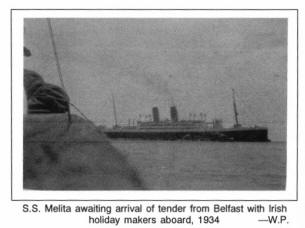 The
Great War, lasting from 1914 through to 1918, occupied
people's minds throughout the United Kingdom of Great
Britain and Ireland, and scarcity of resources, surely shut
out the idea of holidaying abroad, and I should think a day
to Newcastle, Bangor, Warrenpoint or Portrush fulfilled the
wishes of people to cast care aside for a while. The Great
Northern Railway Company simplified the means of getting to
the seaside from Dromore and it was not unusual to meet
local business people strolling on the promenade in
Newcastle any Thursday afternoon in the summer, taking
advantage of the facility on early closing day. Longer
holidays were geared to school closings which were much more
meagre in the twenties, thirties and even forties and
fifties than they are in the nineties. The
Great War, lasting from 1914 through to 1918, occupied
people's minds throughout the United Kingdom of Great
Britain and Ireland, and scarcity of resources, surely shut
out the idea of holidaying abroad, and I should think a day
to Newcastle, Bangor, Warrenpoint or Portrush fulfilled the
wishes of people to cast care aside for a while. The Great
Northern Railway Company simplified the means of getting to
the seaside from Dromore and it was not unusual to meet
local business people strolling on the promenade in
Newcastle any Thursday afternoon in the summer, taking
advantage of the facility on early closing day. Longer
holidays were geared to school closings which were much more
meagre in the twenties, thirties and even forties and
fifties than they are in the nineties.
Primary schools were shut for a week or ten days at
Easter and Christmas, a week at potato harvest time and five
weeks between July and August. Money to spend on hotel or
even boarding house residence was not readily available but
some boarding houses in Newcastle provided a kind of
self-catering arrangement. Holiday makers could obtain a
room and the cooking services of the landlady while
providing the food for themselves-a useful arrangement
particularly for the families of farmers when butter, eggs,
bacon, potatoes and other foods could be brought from home,
and a week or more at the seaside became feasible. In those
days the children were often packed off to stay with Grandma
for the summer holidays which made a nice change especially
if Grandma lived some distance away, - in my case ten miles
was quite a distance and many of my early y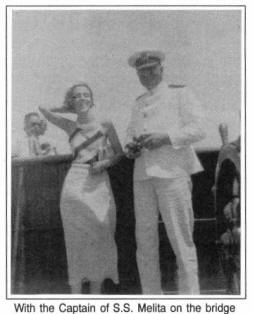 ears
summers were spent like this. ears
summers were spent like this.
In the twenties the Boy Scout and Girl Guide Movements
were growing. Summer camps for all ages of youth became
popular, when bell tents were erected, palliases were filled
with straw from some nearby farmyard to prevent the young
body having to sleep on bare ground and in some cases have
the company of swarms of earwigs. Primitive kitchens were
set up to enable the youth to practise their cooking skills.
During the thirties ownership of motor cars increased
dramatically and influenced the holiday making propensities
of the populace. Soon Donegal, Galway, Killarney or Cork
were almost as accessible as Portrush or Ballycastle and
indeed the idea of leaving the island for a trip abroad
emerged.
In the mid thirties a friend invited me to accompany her
on a " Mediterranean Cruise" and the memories of that
twelve-day holiday are still quite vivid. �1 a day in 1994
may seem a very small sum to pay for a holiday into the sun,
with wonderful food and the opportunity to visit such places
as Cadiz in Spain, Ceuta in Morocco, Funchal in Madeira and
Lisbon in Portugal before recrossing the Bay of Biscay and
the Irish Sea. However that constituted more than a month's
salary for me then. Add to that the need for a comprehensive
wardrobe of suitable clothing to cover the many occupations
aboard ship and the trips ashore, and three month's salary
was required.
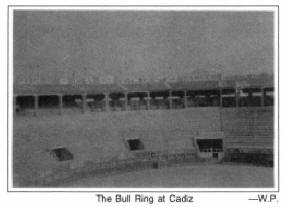 We
joined
S.S. Melita which hove to at the mouth of Belfast Lough,
having come from Scotland, via tender from Belfast Docks.
The excitement was immediate though the next twenty four
hours were occupied in finding our sea legs before joining
in all the activities on board such as deck quoits and other
games, swimming in the pool, sun-bathing, after dinner
dancing, orchestral concerts or film shows. Outward bound
the first port of call was Cadiz in south-west Spain where,
with the help of tugs, Melita tied up to the quay early in
the morning. The day was spent visiting impressive churches,
and doing a little shopping. Initially we were taken to a
bullfight arena where we were amazed at the immense size
with its tiered seating. The torero, however, being confined
to Sunday action, and this being midweek, we were spared
having to watch the gory spectacle, and were satisfied to
inspect the elaborate costumes of the toreadors, picadors,
and matadors accompanied by a guide's description of the
noise, dust and gore, which marked the Sunday afternoon
entertainment of the local populace. The day ended with
dancing at a We
joined
S.S. Melita which hove to at the mouth of Belfast Lough,
having come from Scotland, via tender from Belfast Docks.
The excitement was immediate though the next twenty four
hours were occupied in finding our sea legs before joining
in all the activities on board such as deck quoits and other
games, swimming in the pool, sun-bathing, after dinner
dancing, orchestral concerts or film shows. Outward bound
the first port of call was Cadiz in south-west Spain where,
with the help of tugs, Melita tied up to the quay early in
the morning. The day was spent visiting impressive churches,
and doing a little shopping. Initially we were taken to a
bullfight arena where we were amazed at the immense size
with its tiered seating. The torero, however, being confined
to Sunday action, and this being midweek, we were spared
having to watch the gory spectacle, and were satisfied to
inspect the elaborate costumes of the toreadors, picadors,
and matadors accompanied by a guide's description of the
noise, dust and gore, which marked the Sunday afternoon
entertainment of the local populace. The day ended with
dancing at a beach hotel and our departure to Ceuta, our next port of
call, took place shortly after midnight.
beach hotel and our departure to Ceuta, our next port of
call, took place shortly after midnight.
The visit to Ceuta included a bus run to Tetuan where we
were escorted through the Arab souk where all kinds of
exotica were on sale and the handcrafted leather bags
appealed to me. The lovely Portuguese island of Madeira was
the highlight of the cruise-the sea in Funchal Bay had the
bluest water I had . ever seen. Everywhere on the island
there were flowers. I was tempted to spend more money than I
could afford on the fine hand-sewn linens. I had to be
satisfied with a very small piece in the shape of a romper
suit for my baby nephew. A large basketwork garden armchair
was my contribution to the jumble of baskets, tables and
chairs which cluttered the decks of Melita when we steamed
homewards. Lisbon was our final land call when we managed a
visit to Estoril and enjoyed a swim in the Atlantic as it
rolled on to the sandy beach.
These `Mediterranean cruises' of the thirties were surely
the beginnings of foreign travel holidays which play such a
significant part in the life of most people nowadays.

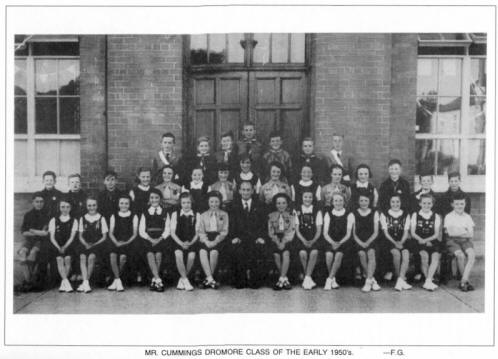
For
Peace comes Dropping Slow.
G. HARRIS CUMMINGS, TEACHER, 1922-1981
By Roy Gamble.
You burrow deep in the recesses of the mind, turning it
out like an old pocket; fingering the debris of forty-odd
years; searching for th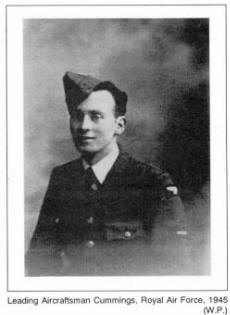 e
elusive glitter of golden memories. And they come only in
fits and starts, a faded flickering news-reel: shadowy
figures; days and dates; half-remembered words. e
elusive glitter of golden memories. And they come only in
fits and starts, a faded flickering news-reel: shadowy
figures; days and dates; half-remembered words.
But the essential element remains: the central character,
clear and bright and tangible; frozen in time like the
powerful outlines of an old-fashioned Daguerreotype
photograph.
He wasn't a big man in the physical sense, but he strode
into the classroom and our lives like a pocket Colossus.
It was the way he carried himself and that dapper sense
of dress that you noticed first, And then there was the
receding hair, the kind eyes, the sympathetic smile.
He was one of those men who was always spotlessly clean
like a surgeon or old-fashioned family doctor. He had about
him an aura of well-scrubbed good health: the apple-red
cheeks, the strong black-haired arms and hands.
On that first day he demonstrated his abhorrence of
corporal punishment with a single dramatic act of dismissal
when he flung the cane, that waspish instrument, down the
back of a tall cupboard that stood at the back of the room.
It was never seen again.
This was G. Harris Cummings: teacher, mentor, enlightened
and compassionate human being; demonstrating, as he was to
demonstrate all his too short life, that actions speak
louder than words.
It was late August, 1949 when he came to us, we fortunate
few who were to benefit from his teaching and his wise and
benevolent presence for the next few memorable years.
His journey to Dromore was circuitous - a five year war
interlude had seen to that. In 1940, with the world already
one year into war,
a youthful Harris Cummings left his father's farm at Woodend,
Londonderry road, Strabane ` and boarded the train for
Belfast. Armed with
his newly acquired Senior certificate he was on his way to
enrol for teacher training. On the journey he shared a
compartment with two
Strabane boys en route to join the Royal Air Force.
No-one will ever know what conversation took place in
that railway carriage. But the rest, as they say, is
history.
He served out his war as an aircraft engine mechanic,
hands permanently grimed with grease and oil as he grappled
with the innards of giant engines, tediously servicing the
heavy bombers that raided nightly into Germany from R.A.F.
Colerne, Wiltshire. M.P.)
Not for him the kudos and glamour of flying duties - but
typical of the man, he accepted his place in the military
scheme of things, served without demur, and later wore his
medals with pride.
He brought to teaching a strength of character forged in
the awful ordeal of conflict, experiencing first-hand the
horror and waste of war. Ground crews, responsible for
servicing operational bombers lived like troglodytes:
sleeping on make-shift beds in dingy airfield crew-rooms;
seeing off the heavily-laden bombers at dusk, waiting as
first light bruised the night sky for them to return, often
shot-up, half their crews (pilots, navigators, wireless
operators, gunners - men Harris Cummings often knew
personally) dead or badly wounded. Or worse still, enduring
the incomprehensible finality of the sudden termination of
the young lives of those who failed to return - shot down
over Dusseldorf, Cologne, Bremen.
There were good times too. Despite the war-time
restrictions on travel there was a chance to see something
of the England he grew to love, and along the way, the
God-sent opportunity to meet, court and wed the charming
Miss Malveen Jones from Bath, Somerset.
Had there been an R.A.F. station at Coleraine, Co. Derry
this last happy event might never have happened, thanks to
the bungling of a movements clerk in some R.A.F. orderly
room. The unfortunate clerk, failing to distinguish between
Coleraine Northern Ireland and Colerne, Wiltshire,
dispatched Aircraftsman Cummings back to Ulster for what was
to prove a very short-lived first posting.
The raising of the school-leaving age in April, 1947
prompted the Teachers Emergency training scheme, and Harris
Cummings became one of the many ex-servicemen to train in
the Emergency teacher college at Larkfield near Belfast.
In "Goodbye Mr. Chips" James Hilton's pre-war novel about
school-mastering, Mr. Chipping's young wife Katherine goes
some little way in summing up Harris Cumming's proud
profession when she addresses her husband: " ` Oh Chips, I'm
so glad you are what you are. I was afraid you were a
solicitor or a dentist or a man with a big cotton business
in Manchester. Schoolmastering is so different, so
important, don't you think ? To be influencing those who are
going to grow up and matter in the world . . .'
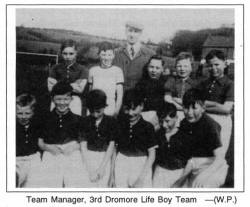 Chips
said he hadn't thought of it like that - or at least, not
often. He did his best; that was all anyone could do in any
job. Chips
said he hadn't thought of it like that - or at least, not
often. He did his best; that was all anyone could do in any
job.
No-one could accuse Harris Cummings of not doing his
best. It was not in his nature to do otherwise. He obviously
thought long and hard and often about his job. As a teacher
he was twenty years ahead of the times. Fingers numb from
caning; the wooden duster flung in anger; the repetitive
rap, rap, rap of the pointer beating out the sing-song
rhythm of times tables played no part in his teaching
methods.
He carried his authority easily, teaching by example.
Never content with merely passing on the fundamentals of the
three R's he opened and expanded young intellects with
wellweighed words and patient encouragement.
An avid exponent of the old adage: "All work and no play
makes Jack and Jill a dull boy and girl" - he was just as
likely to shout, in the middle of a particularly tedious
lesson:
"Right, close your books," and splitting the class into
teams, begin an energetic refereeing of a no-holds-barred
general knowledge quiz.
Impromptu classroom concerts were also a periodic pleasure
when he would act the yokel and sing, whistle and grunt his
way through:
"There was an old farmer who had an old sow, (Wheep,
grunt, deedily-dan)
Who took her to market some goods for to buy, (Wheep,
grunt, deedily-dan),
Sing Lassie go-ring go-ro Susannah's a funniful man (Wheep,
grunt, deedily-dan.)"
"Do the Welsh railway station," we would shout, and he
would oblige, rolling his tongue round that elongated
jawbreaker of a place-name on some remote Anglesey
branch-line, syllabically correct and complete with
appropriate accent: LLanfair-pwill-gwyn-gyll-goger
ychwyrn-drobwll-llanty-siliogogogoch. Which means, as he was
always at pains to point out: the church of St. Mary's by
the white hazels over the whirlpool close by the church of
St. Trisilias by the red cave!
These polished performances came as no surprise for he
had already appeared on the stage proper, treading the
boards in two of Dromore Cathedral dramatic society's
productions in 1950. "In a Glass darkly" a one act play by
Muriel Box, he starred in the role of love-lorn portrait
painter Robert Keene. Later he was cast as the 'boy-friend'
in a three-act comedy called "The Younger generation" by
Stanley Houghton.
Harris Cummings was a child of the Empire. Born at a time
when at least a third of the globe was shaded a bright
Britannic pink, he made no apology for being a Royalist and
a supporter of the Union. This is not to say that he
possessed a "Little Englander, the sun never sets on our
dominions" mentality, for he was much too thoughtful and too
much an Ulsterman for that. Nevertheless, he was still an
ardent admirer of British achievements and he was happy to
be part of local celebrations for the Festival of Britain in
1951 and again in 1953 when Queen Elizabeth the second was
crowned.
His love of things English was always evident as he
coloured lessons with mental pictures of the villages and
shires and traditions of England. A lifelong lover of sport,
he introduced us to cricket - that most quintessential of
English pastimes and to the voice of that fine radio
commentator, John Arlott, often breaking into a highly
passable impression of that marvellous Hampshire burr: "And
Trueman comes in to bowl as the pigeons `roise' at the
pavilion end . . . "
I think it was John McGahern the writer who said "There
are no days more full in childhood than those days lost in a
favourite book." Harris Cummings, normally an advocate of
action, recognized this, and despite the busy grammar school
qualifying curriculum, encouraged our first exciting
insights into those imaginative books: `Treasure Island'
"Kidnapped' `The Wind in the Willows' `The Kon-Tiki
Expedition.'
He was moved by curiosity and it rubbed off on those
taught. He had this capacity to transport his pupils to
far-flung places: Africa, India, China. It was not so much
the basic factual knowledge ( though there was that too )
rather the sense of adventure he engendered so that we
barely noticed the facts and figures and dates along the
way.
It is strange that he, most practical of men, should have
been the one to stir that first small flame of poetry,
putting an end forever to the `Half a league half a league
half a league onward' breathless chanting. "Emphasis the
`Peace comes dropping slow,'" he would enjoin and proceed to
recite in drawling demonstration those lovely lines from W.B.
Yeats' "The Lake isle of Innisfree."
"And I shall have some
peace there,
For peace comes dropping
slow,
Dropping from the veils of
the morning
To where the cricket sings;
There midnight's all a
glimmer,
And noon a purple glow,
And evening full of the
linnet's wings."
The era following the ending of the second world war was
a particularly drab time in the United Kingdom. Austerity,
utility and rationing all continued into the early fifties.
Only a tiny percentage of the population owned cars, and for
most Dromore children, a once a year steam train Sunday
school excursion to Newcastle was all that expected in the
way of travel. Some of us had not yet been to Belfast in
1950. Harris Cummings changed all that. With almost military
precision ( right down to the exact amount of money required
for trolley-bus fares ) he organised several highly
educational trips to the capital. Small beer now-a-days
perhaps compared to school trips to London, Paris and Rome;
we nevertheless enjoyed our visit to parliament buildings at
Stormont, where, never one to miss an opportunity to impart
knowledge, he delivered an off-the cuff geography lesson
over a fine bronze relief map of Ireland laid out in the
imposing foyer of the parliamentary pile.
Later there were visits to the Ulster museum, the Zoo,
and the Victorian grandeur of the palm house in the Botanic
gardens. And of course, there was the piece-de-resistance of
each and every trip - lunch in the massive Woolworth's
cafeteria in High street. The height of culinary
sophistication !
I was twice blest in my relationship with Harris
Cummings, for not only was he my revered schoolteacher, he
was my leader in the 3rd Dromore Life Boy team (the junior
section of the Boy's Brigade) an organization he loved and
led with pride.
Trips to Belfast continued as he organised highly
competitive football matches and other get-togethers with
City Life-Boy teams.
Someone once described a religious person as, "One who
believes that life, and its aftermath, is about making some
kind of spiritual journey." Harris Cummings was one such
person. A deeply Team Manager, 3rd Dromore Life Boy Team -(W.P.)
religious man, I can still picture him leading our
adolescent voices in singing the vesper hymn at the close of
another Monday Life Boy meeting. Hushed singing, after an
evening of disciplined activities and boisterous boyish fun,
the late Summer sun shafting through the high windows of the
church hall:
"The day thou gavest,
Lord is ended,
The darkness falls at thy
behest;
To thee our morning hymn
ascended,
Thy praise shall sanctify
our rest."
A short time after I left Dromore primary school, Harris
Cummings took up an appointment as Principal of the new
school in Loughbrickland. It might as well have been on the
other side of the world. Now and then, as is the way of
things, news of him would filter through: his successes with
11 plus candidates; his M.B.E. for outstanding service to
the Ulster savings committee; Presbyterian church
activities; Presidency of the Royal British Legion; his
formation of the first Loughbrickland Boys Brigade company.
All news was good news.
I only ever saw him one more time; sometime in the middle
seventies. It was in a crowded Banbridge street thronged
with Saturday shoppers. He had put on a little weight; grown
a little smaller. I didn't have the temerity to stop and
introduce myself, but shyly said hello and passed on. The
gap of our acquaintanceship was too wide, and besides, he
was still, as he always will be, Master Cummings, my
extraordinary and highly-respected teacher.
He died in January, 1981 having suffered from that most
cruel of illnesses, pancreatic cancer. To the end he was
courageous. " Are you in pain ?' they would ask. " It's only
a niggle, " he would reply. " Only a niggle. "
To this day I bitterly regret never having gone to see
him. To thank him for his good influence on my life, for
happy Life-Boy memories and for the shining example he gave
to all who sat at his feet in his classroom.
He always sought the best in people, refusing to belittle
anyone; rather seeking the hidden good.
"And still they gazed, and
still the wonder grew,
That one small head could carry
all he knew.
But past is all his fame. The
very spot
Where many a time he triumphed,
is forgot."
Let these few lines from Oliver Goldsmith's
"The Village Schoolmaster" be a fitting epitaph - with the
exception perhaps, of the final couplet. For no-one, least
of all this ageing former pupil, could easily let go the
memory of the phenomenon who was G. Harris Cummings.
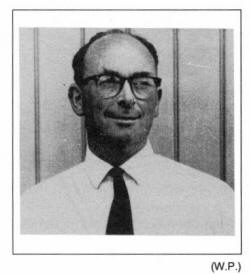
 |